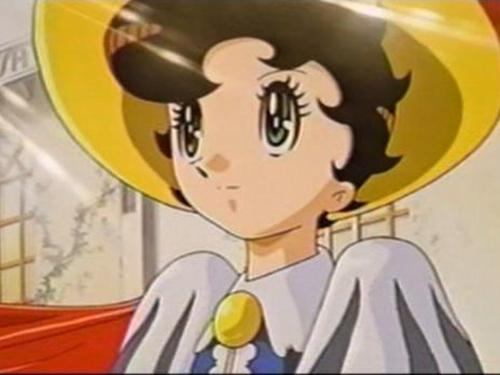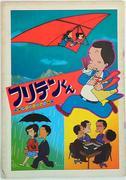Review of "The King's Tail": A fusion of fascinating characters and a deep story

"The King's Tail": A hidden masterpiece of postwar Japanese animation■ Public Mediatheater ■ Original MediaAnime Original ■ Release dateOctober 1949 ■Frequencies33 min ■ Number of EpisodesEpisode 1 ■Original Story・Original story: Iwasaki Taro (Iwasaki Taro) ■ Production・Produced by Nippon Manga Eigasha ■ StoryA prince is born in the fox kingdom, but due to some kind of mutation, the prince does not have a bushy tail, which should be a symbol of authority. The king and his senior officials are troubled and call a meeting. As a result of the meeting, a clause is added to the 100th article of the fox kingdom's constitution stating that "it is unacceptable to show your tail in front of the prince," and a proclamation is issued throughout the city. Posters of the tail on the wall are also erased, and even the bronze statue's tail is destroyed. One day, when the prince has grown up, he knocks a bean off the table during a meal. When the waiter tries to pick it up, his tail sticks out of his trousers. When the prince questions this, the senior official gives an awkward reply that it is a shoddy stick. The prince inherits the throne, and one day decides to inspect the whole country. The people are busy trying to hide their tails. The people welcome the king's carriage with a big welcome, hiding their tails. One day, the king was attending an orchestra concert when the conductor, who was hiding his tail and concentrating on conducting, had his trousers torn, causing his tail to pop out. He witnessed this and fainted in shock. Eventually, the king learned that all the people had beautiful tails, which were the pride of the Fox Kingdom. And it was the fact that they had to hide their tails that caused the problem. The king issued a decree that he would no longer order people to hide their tails, even if they did not have their own tails, and the people were overjoyed. ■ExplanationSeo Mitsuyo joined Nippon Manga Eigasha in January 1948. He began planning a new film in March. The theme was Andersen's "The Emperor's New Clothes," and the main character was a tailless fox king, with the intention of making people think about the custom of blind obedience to authority and the correct form of democracy. Takagi Toroku was asked to compose the music. Animation began with blur recording. A total of 4,000 animators were mobilized to create the animation. Hundreds of thousands of drawings were made, and 30,000 sheets were used. Although it was a black-and-white film, twelve colors of paint were used. Production was halted midway due to a lack of funds, and it took a year and ten months to finally complete in October 1949. The film was originally 4,200 feet long, but was cut to 3,000 feet because it was too long. The total cost was an unprecedented six million yen for the time (this figure includes Nippon Cartoon Movie Company's accumulated losses, so the actual figure was less), and the film was scheduled to be released as a double feature with Flaherty's documentary Nanook of the North Pole by Toho, but was cancelled on the orders of Toei's then president, Yonemoto Uokichi, for the content was deemed too questionable. It was never released to the public. The huge production costs of this film led Nippon Cartoon Movie Company to go bankrupt. Seo Mitsuyo also left the world of animated films, changing his name to Seo Taro and moving into animation art. Animator Fukui Eiichi later became a successful children's manga artist. His most famous work is the judo manga Igaguri-kun. After reading "The King's Tail," Tezuka Osamu was inspired by it to write the sci-fi masterpiece "Zero Man" (1960), featuring a boy with a tail who was half squirrel and half human as the protagonist. He later wrote another sci-fi picture book for children, "Bis Bis Bis Star Story" (December 1975, published by Daitosha), which told the story of tail-equipped planet inhabitants. The afterword to this work reads, "This is an unpublished work from roughly more than twelve years ago. Shortly before drawing this, I created "Zero Man," a story about a child with a tail. The reason I am so obsessed with tails is because of a cartoon movie called "The King's Tail" that I saw shortly after the war. That movie was an imaginary fairy tale that combined The Fox King with Andersen's "The Emperor's New Clothes." It was a very beautiful and charming manga. "The Story of the Planet Biz Biz Biz" is, of course, a completely different story. It is somewhat more adult-oriented. I have added some science fiction flavor to it, and have recently added some parts. I would like to dedicate this work to all the staff who worked on "The King's Tail," which was never released and, after all the hard work, never saw the light of day." ■ Main staff Produced by Nippon Manga Eigasha, Planning by Yasufumi Suzuki, Original Story by Taro Iwasaki ■Detailed review"The King's Tail" occupies a very important place in the history of Japanese animation films made shortly after the war. The film makes viewers think deeply about blind obedience to authority and the nature of democracy, and can be said to reflect the social situation at the time. Below, we will take a detailed look at the background, production process, and influence of this work. Background and Theme"The King's Tail" was released in 1949 but was never released to the public. However, the story is based on Hans Christian Andersen's "The Emperor's New Clothes," satirizes blind obedience to authority, and questions the correct form of democracy. In Japan, shortly after the war, there was a demand to break away from traditional authoritarianism and build a new democratic society. This work reflected the social situation and provided viewers with deep insight. Production ProcessThe production of this film began with Seo Mitsuyo, who joined Nippon Cartoon Eigasha in January 1948. Seo conceived a story based on Andersen's "The Emperor's New Clothes," with a tailless fox king as the main character. A total of 4,000 animators were mobilized for the production, and hundreds of thousands of drawings were made. Although it was a black-and-white film, 12 colors of paint were used, and the drawings were extremely detailed. However, midway through the production, the production ran out of funds, and it took a year and ten months to finally complete. The film was originally 4,200 feet long, but was cut to 3,000 feet because it was deemed too long. The total cost was 6 million yen, an extraordinary amount for Japan at the time, but the actual cost is thought to have been less because it includes Nippon Cartoon Eigasha's accumulated losses. Influence"The King's Tail" was not released to the public, so its direct influence was limited. However, Osamu Tezuka, who saw this work, was greatly influenced by it in his subsequent works. Tezuka was inspired by "The King's Tail" to create the sci-fi masterpiece "0-Man," which has a boy with a tail as the protagonist, and continued to pursue the theme of tails in works such as "Biz Biz Biz Planet Story." In addition, animator Eiichi Fukui, who participated in the production, became active as a children's manga artist and created his signature work "Igaguri-kun." Furthermore, after the failure of this work, Mitsuyo Seo switched from animated films to animated art, embarking on a new path. From these examples, it can be said that "The King's Tail" had a great influence on postwar Japanese animation and manga. ■ Recommendations and ratings"The King's Tail" was not released to the public, so there are limited opportunities to see it. However, its content is very deep, and it deals with themes that are still relevant today. This work, which makes you think about blind obedience to authority and the nature of democracy, is something that I would especially recommend to the younger generation. It is also an important work for understanding the history of animation, so I would definitely recommend watching it at least once. ■ Related works and recommendationsWorks related to "The King's Tail" include Osamu Tezuka's "0 Man" and "Bis Bis Bis Planet Story." These works continue the theme of "The King's Tail" but develop the story from a new perspective. Eiichi Fukui's "Igaguri-kun" is also important for understanding the manga culture of postwar Japan. By watching these works together, you will be able to gain a deeper understanding of the significance and influence of "The King's Tail." ■ Summary"The King's Tail" is a work that occupies a very important place in the history of postwar Japanese animation films. It is a work that makes you think deeply about blind obedience to authority and the nature of democracy, and can be said to reflect the social situation at the time. By providing a detailed explanation of the production process and influences, and recommending related works, we hope to reevaluate the significance and value of this work. We encourage you to watch it at least once and enjoy its profound themes and beautiful artwork. |
Recommend
"The Parasol Song": Reevaluating the moving song of the people
The appeal and evaluation of "Poem of Paraso...
The appeal and reviews of "Himitsu no Aipri": An anime experience you can't miss
"Himitsu no Aipri" - A fascinating new ...
The movie "Sonic the Hedgehog 3" is released today. The cute and super-hero will ignite 2025
The movie "Sonic the Hedgehog 3" produc...
Blade Runner live-action drama to be produced with 10 episodes, script already written
According to Variety, director Ridley Scott revea...
"Batman" Ben Affleck ends alcohol treatment: Thanks to family, friends and fans for their support
According to foreign media reports, Ben Affleck, ...
New stills of horror film "Megan 2" released, the killer AI doll is back
Recently, new stills of the sequel to the popular...
ONE PIECE Dream Soccer King! - A thorough analysis of the ultimate match
"ONE PIECE Dream Soccer King!" - A heat...
Netflix's original stop-motion animation "Lila Bear and the Amusement Park" reveals the new adventure of the lazy bear
Today, October 27, Netflix announced that the seq...
The Ultimate Battles: The Ultimate Kings Special Screening: A Cry from the Soul! - Evaluating the Series' Greatest Battles
A comprehensive review and recommendation of &quo...
The appeal and evaluation of Gainata Mugger: A must-read review for anime fans
Gainata Mugger: A short anime packed with the cha...
The new trailer of "Line Walker 2" is released. Hello everyone, I am Louis Koo, Zha Zha Hui
Recently, the police and gangster action film &qu...
The second season of the TV animation "Fictitious Mystery" has been confirmed! The trailer has been released
Today (November 27), the official has confirmed t...
2020 Golden Raspberry Awards full list: Worst Film - "Cats"
Due to the epidemic, the 2019 Golden Raspberry Aw...
Review of "Aharen-san wa Hakarenai": The appeal of mysterious characters and a deep story
Aharen-san is Unmeasurable - Aharen-san is Unmeas...
Marvel's Captain America: Brave New World reportedly received 'terrible' test responses
According to entertainment gossip social media ac...





![A touching episode depicting Nintama Rantaro's efforts and kindness [All you can do is try your best (2)]](/upload/pic/08805.jpg)



